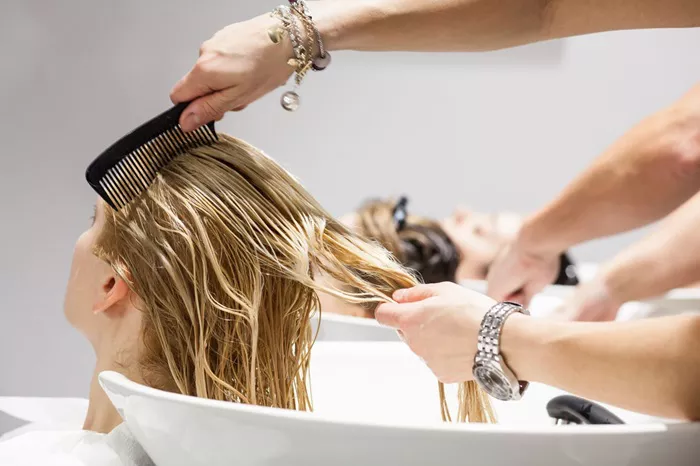Detox hair treatment is a deep-cleansing process designed to remove impurities from your hair and scalp. Over time, hair accumulates residue from styling products, environmental pollutants, hard water minerals, and natural oils. This buildup can weigh hair down, making it look dull and feel lifeless. A detox treatment strips away these impurities, restoring your hair’s natural shine and vitality. Think of it as a “reset button” for your hair care routine.
Why Detox Your Hair?
Hair is exposed to many elements daily. Styling products like gels, sprays, and serums leave behind residue. Pollution, sweat, and hard water (water high in minerals like calcium and magnesium) add layers of grime. Even natural scalp oils can build up over time. Without regular cleansing, this mix creates a barrier that prevents moisture and nutrients from penetrating the hair shaft.
Signs You Need a Detox:
- Hair feels sticky, greasy, or heavy.
- Loss of volume and bounce.
- Dullness, even after washing.
- Itchy or flaky scalp.
- Products seem less effective.
How Detox Hair Treatment Works
- Detox treatments work in three stages: remove, balance, and nourish.
- Remove Buildup: Special formulas with ingredients like activated charcoal or clays bind to impurities and wash them away.
- Balance the Scalp: Detoxing regulates oil production, preventing an overly dry or oily scalp.
- Restore Moisture: Many treatments include hydrating agents to counteract dryness caused by deep cleansing.
Key Ingredients:
- Activated Charcoal: Acts like a magnet for dirt and oil.
- Apple Cider Vinegar: Balances scalp pH and dissolves residue.
- Bentonite Clay: Absorbs toxins and excess oil.
- Chelating Agents: Neutralize hard water minerals.
Types of Detox Hair Treatments
Clarifying Shampoos:
Stronger than regular shampoos, these contain sulfates or natural cleansers to tackle stubborn buildup.
Best for: Occasional use (every 2–4 weeks). Avoid if you have color-treated or very dry hair.
Scalp Scrubs/Exfoliators:
Physical or chemical exfoliants (e.g., sugar, salicylic acid) slough off dead skin cells and unclog follicles.
Tip: Gently massage scrubs to boost circulation.
Detox Masks:
Leave-on treatments with clays or oils draw out impurities. Often paired with heat for deeper penetration.
Example: Mix bentonite clay with water and apply to damp hair for 15 minutes.
Professional Salon Treatments:
Stylists use high-grade products or techniques like steam to detoxify. Some treatments bond with metals (e.g., from hard water) for ultra-clean results.
Investment: Pricier but ideal for severe buildup or sensitive scalps.
How Often Should You Detox?
Frequency depends on your hair type and lifestyle:
- Oily Hair/Heavy Product Users: Every 1–2 weeks.
- Normal/Dry Hair: Every 3–4 weeks.
- Color-Treated Hair: Use sulfate-free formulas monthly to prevent fading.
Over-Detoxing Risks: Stripping natural oils can cause dryness. Watch for brittleness or frizz and adjust accordingly.
Benefits of Regular Detoxing
- Healthier Scalp: Reduces dandruff and itching by keeping follicles clear.
- Brighter Hair: Removes dulling residue for enhanced shine.
- Better Styling: Products adhere better to clean hair.
- Long-Term Growth: A clean scalp promotes stronger roots and less breakage.
DIY vs Professional Detox Treatments
DIY Options:
- Apple Cider Vinegar Rinse: Mix 1 part vinegar with 2 parts water. Post-shampoo, pour over hair, then rinse.
- Baking Soda Scrub: Combine 1 tbsp baking soda with shampoo (use sparingly—it can be drying).
- Coconut Oil Mask: Massage warm oil into the scalp; rinse after 30 minutes to lift dirt.
Precautions: DIY recipes can disrupt pH if overused. Always follow with conditioner.
Professional Treatments:
Salons offer customized solutions, like:
- Chelating Treatments: Target hard water buildup.
- Scalp Peels: Use acids to exfoliate gently.
- Steam Detox: Opens cuticles for deeper cleansing.
Aftercare Post-Detox
After detoxing, hair may feel dry. Replenish moisture with:
- A hydrating conditioner or hair mask.
- Leave-in serums with argan or jojoba oil.
- Avoid heavy styling products for 1–2 days to let hair breathe.
Common Myths and Mistakes
- Myth: “Detoxing is just for oily hair.”
Truth: All hair types benefit; adjust frequency and product strength. - Myth: “More detoxing equals healthier hair.”
Truth: Overuse can damage. Stick to a schedule. - Mistake: Skipping conditioner. Always hydrate after detoxing.
Choosing the Right Products
- Color-Treated Hair: Opt for sulfate-free clarifiers.
- Curly Hair: Use creamy detox masks to retain moisture.
- Sensitive Scalp: Seek fragrance-free options with soothing aloe or tea tree oil.
Conclusion
Detox hair treatments are essential for maintaining vibrant, healthy hair. By removing buildup, balancing the scalp, and restoring moisture, they address issues that regular washing can’t. Whether you choose DIY methods or salon services, consistency is key. Tailor your routine to your hair’s needs, and enjoy the transformation—from lifeless to luminous.
Related topics:
What is Metal Detox Hair Treatment?
What Is Good Treatment for Hair?
7 Best Shampoos for Oily Scalp and Dry Hair


